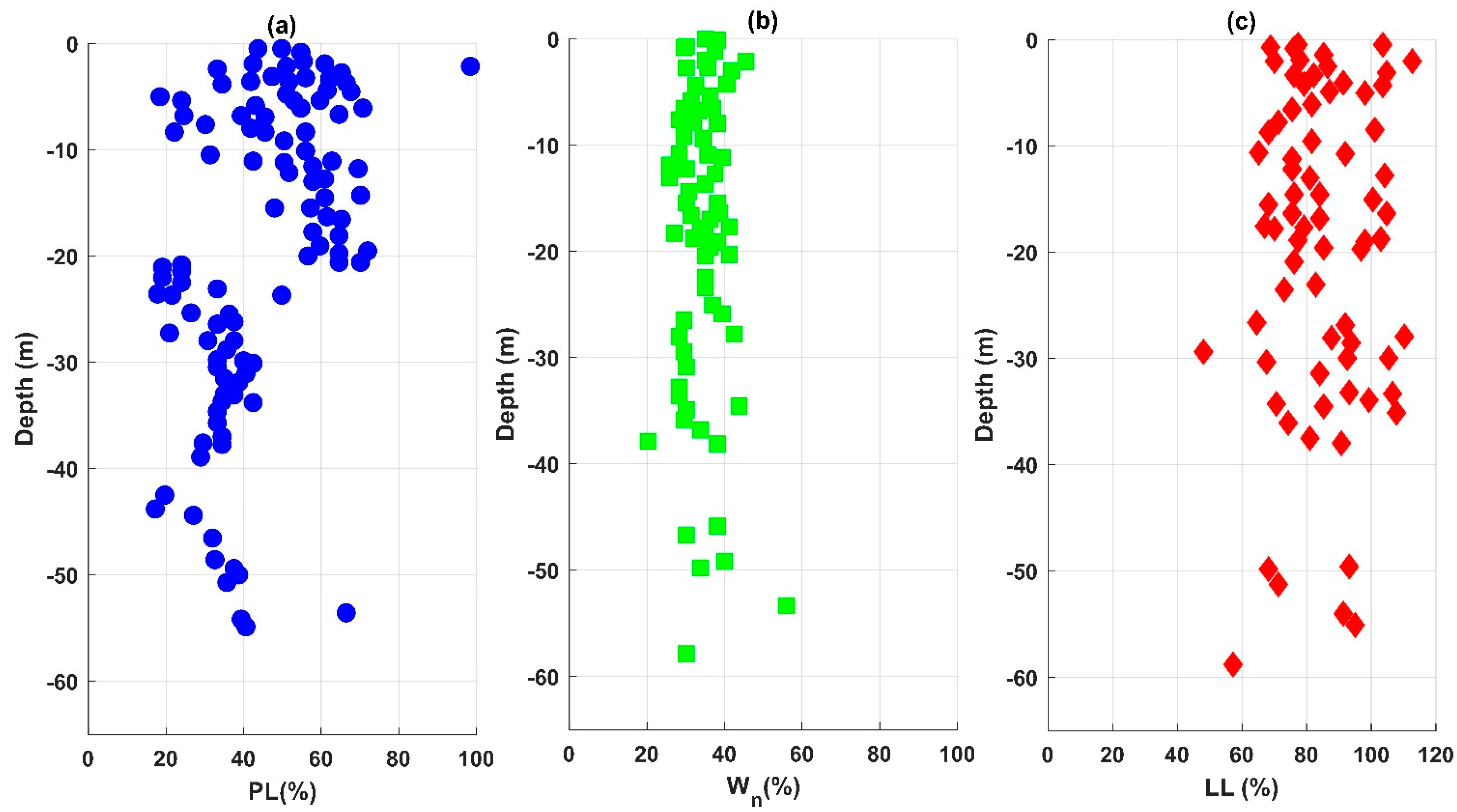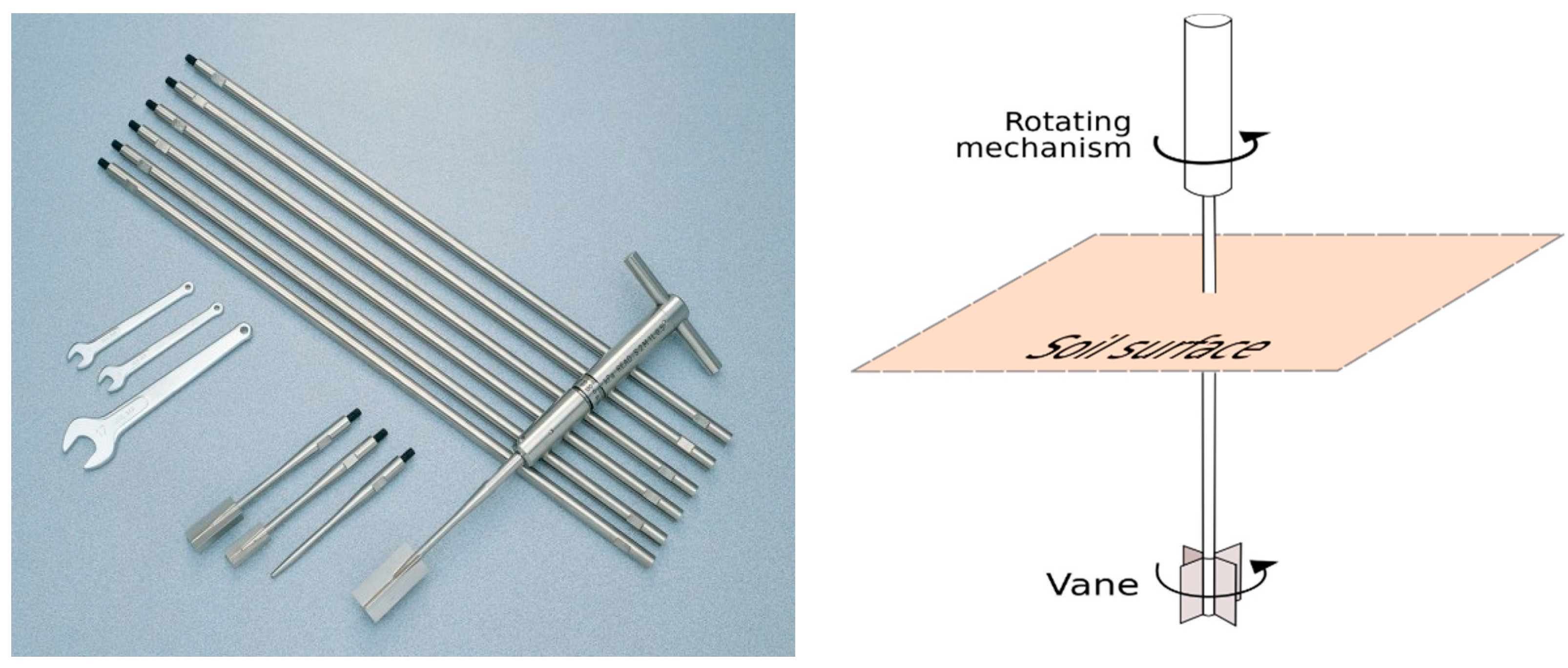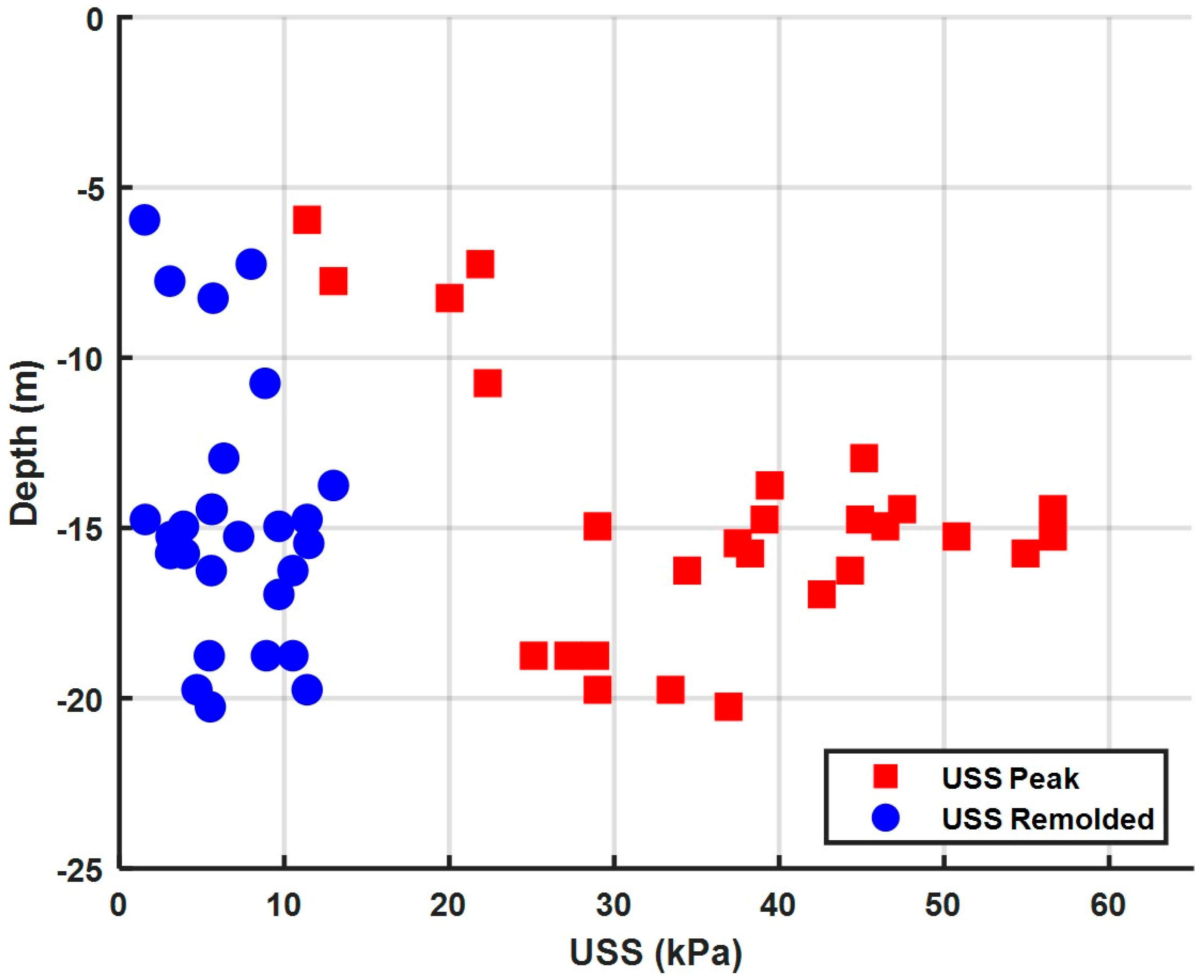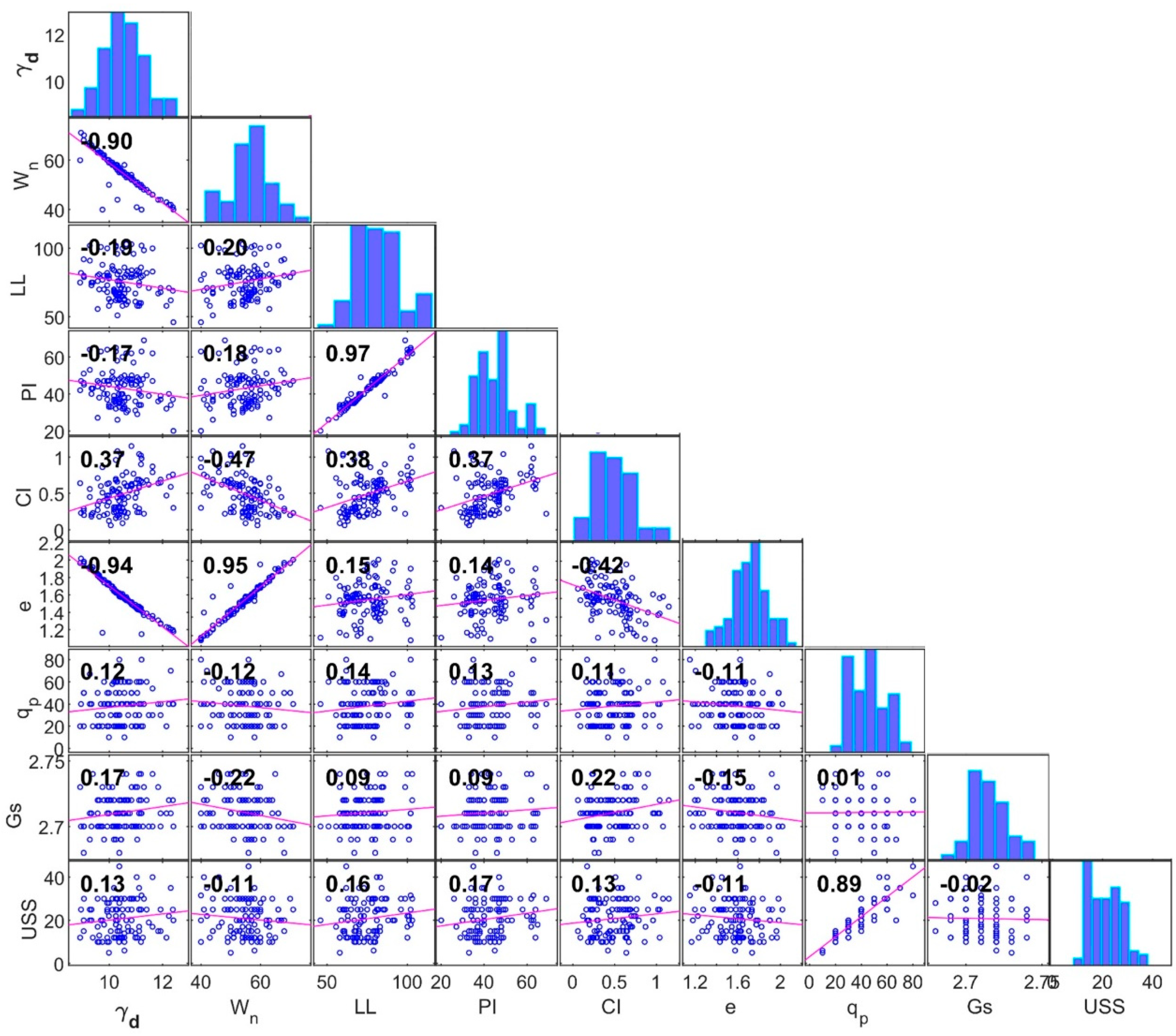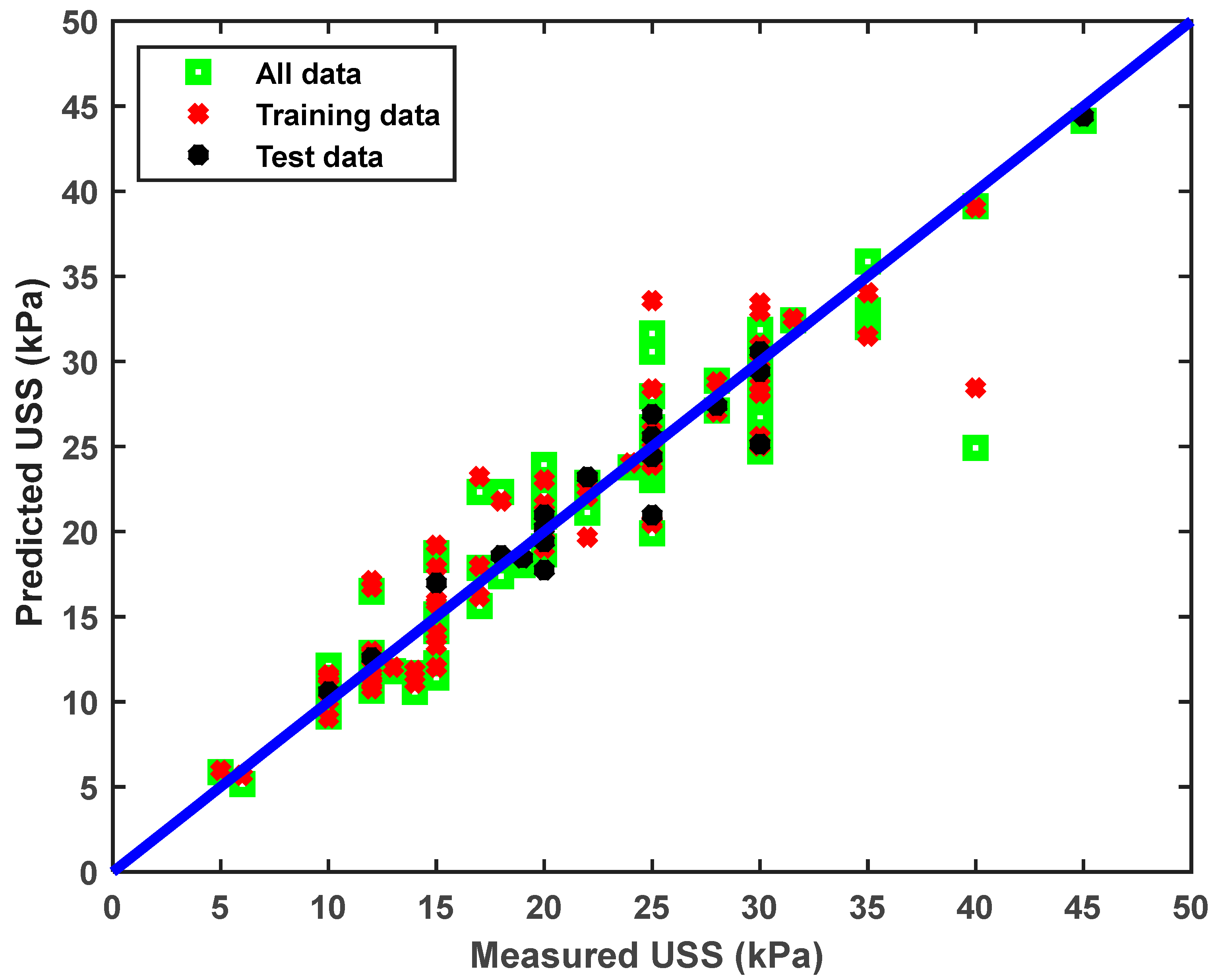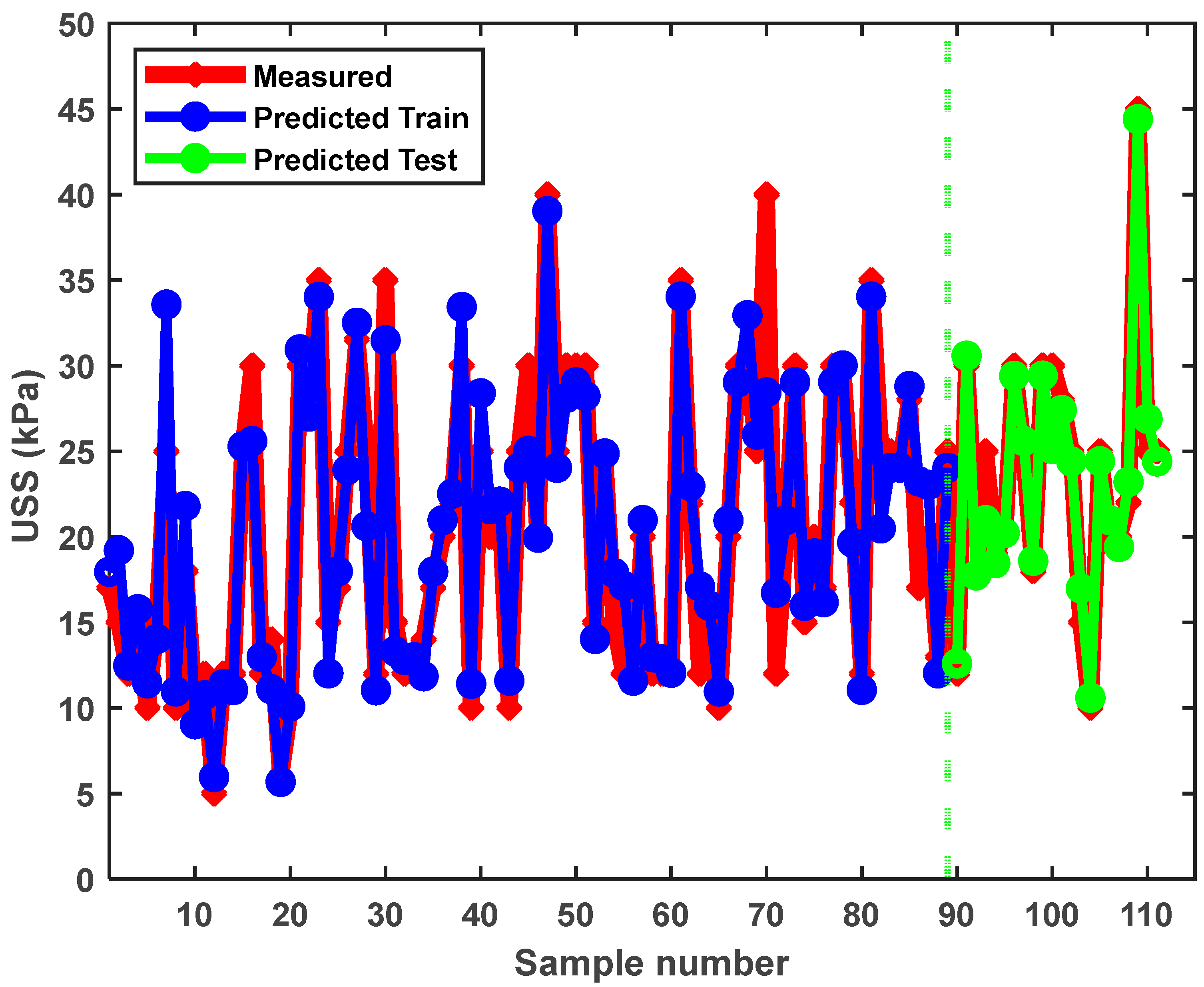1. Introduction
Patches of soft soil are distributed throughout many vital regions near oceans, seas, and rivers. These regions are essential for human activities and the development of various structures such as roads, bridges, embankments, buildings, railroads, tunnels, etc., and new cities are also constructed on this type of soil. The problems presented by soft soil are high compressibility and low shear strength. Moreover, structure settlement continues for long periods. The failure of structures mainly occurs due to a lack of soft soil shear strength. Soft soil is one of the problematic soils encountered all over the world. Consequently, the “soft soil” [
1], is defined as soil that typically exhibits an undrained shear strength (USS) in the range of 20 to 40 kPa, while the very soft soil possesses USS values of less than 20 kPa. The performance of soft soil depends not only on water content, but also on its structure. Generally, the soft soil remains stiff in the dry state until it is subjected to a drastic increase in its water content, at which it converts to weak and soft soils [
2]. The saturated soft soil causes several problems for structures on it, such as low bearing capacity and long-term excessive settlement [
3]. Constructing heavy structures on native soft clay soil is a difficult task. The geotechnical design depends mainly on the (short-term) undrained shear strength of the soft soil, as it has a smaller value compared to that of the (long-term) drained shear strength.
Hence, the undrained shear strength of the soft soil is the most important parameter to be determined when calculating its bearing capacity. The selection of suitable improvement methods for the sensitive clay is also mainly dependent on the accurate values of its undrained shear strength. However, there is a difficulty associated with extracting and sampling the soft soil, especially the very sensitive soft clay. The sensitive clay usually has an undrained shear strength in the laboratory smaller than that in the field due to the effect of disturbance on the sample. Since the design of structure foundations depends on the undrained shear strength of the sensitive clay, it must be carefully determined and evaluated from the results of both field and laboratory tests.
The precision of the laboratory tests, such as direct shear, unconfined compression, or undrained triaxial compression, significantly depend on the quality of the collected sensitive, undisturbed clay samples [
2,
4], and additionally rely on the thickness and the friction of the sharp edges of the circular samplers with soil. On the other hand, field test results (field vane test and piezocone cone penetration test—CPTU) are also influenced by selection techniques [
5,
6]. In 2021, Ayadat [
4] stated that the field vane shear test is more accurate than the Swedish cone shear test.
Due to the difficulty of determining the undrained shear strength of the sensitive clay, empirical equations are utilized based on clay properties, like clay activity and Atterberg limits [
4,
7,
8,
9,
10,
11], water content, plasticity index, and over consolidation ratio [
12]. However, there is a shortage of past studies that investigate the functional form and the influential soil properties of the existing empirical correlations. Moreover, Mataic et al. [
13] stated that pre-consolidation pressures can differ significantly owing to soil disturbances during sampling, which occasionally causes unpredictable values of the pre-consolidation pressures. Subsequently, empirical correlations include only a few soil parameters despite there being greater soil parameter influences on the undrained shear strength of the soft soil.
Recently, machine learning (ML) models have been widely utilized to predict the same important soil parameters that are costly, time-consuming, and require great effort to determine in the laboratory or the field. Generally, machine learning has been recently used by geotechnical engineers in the prediction of skin friction of driven piles [
14], the bearing capacity of shallow foundations [
15], or the shear strength of soil [
16,
17,
18]. ML models are rarely used to estimate undrained shear strength of soft soil based on different geotechnical properties [
12,
19,
20]. In 2022, Tran et al. [
6] only utilized ML models in the prediction of the undrained shear strength for marine-sensitive soft soil, with a coefficient of correlation of 0.715.
Predictions of undrained shear strength of the alluvial sensitive soft clay using ML advanced modeling have not yet been thoroughly studied by geotechnical researchers. Therefore, the main objective of the current research was to introduce an accurate ML model to predict the undrained shear strength of sensitive alluvial soft clay using many important soft clay soil properties. The ML models have been formulated using a realistic dataset. The advantage of the ML model is to make an accurate prediction for the undrained shear strength of alluvial sensitive soft clay, in order to avoid disturbance difficulty during its extracting and sampling. Moreover, handling and performing shear strength tests on very soft and soft soil, either in the field or in the laboratory, typically comes with high costs, is time-consuming, and requires hard work and effort from geotechnical staff. ML prediction of the undrained shear strength of sensitive clay is expected to introduce significant savings in the above-mentioned factors. The ML models predict undrained shear strength based on soft clay essential properties, which can be easily determined in the laboratory. Soft soil properties, acting as predicting features, include moisture content, specific gravity, void ratio, dry unit weight, liquid limit, plasticity and consistency indexes, and pocket penetration shear. In this context, the ML model has been formulated using precise realistic datasets (features) for the sensitive soft clay samples collected from the delta region of Egypt, located in northern areas of the Nile River. Generally, alluvial soft clay regions are very crowded all over the world, with various structures like roads, embankments, bridges, railways, tunnels, airports, buildings, etc. The accuracy of the ML models is evaluated by the coefficient of correlation method. An accurate ML prediction of the undrained shear strength will achieve sustainably for the structures on non-treated or treated sensitive soft clay by gathering between its long-term high performance and economic side. The used undrained shear strength values of the sensitive clay were determined from the results of precise field vane shear tests. Collecting realistic and feature-enriched datasets, along with the selection of the appropriate algorithm, led to a substantial improvement in the prediction accuracy of the model.
2. Materials and Methods
The soft clay is located in northern areas of the Nile River, in Egypt. The sensitive clay was formed in alluvial sediments. For the ML model study, 111 soft clay samples were collected from the northern Nile delta. The data set included geotechnical features of natural water content (W), dry unit weight (γd), liquid limit (LL), plasticity index (PI), consistency index (CI), void ratio (e), specific gravity (Gs), and pocket penetration shear (qp). The utilized features were easily determined or calculated from the geotechnical laboratory tests. The performed experimental tests were natural water content, specific gravity, bulk density, liquid and plastic limits, and Pocket penetration, according to ASTM numbers D 2216, D 854, D1556, D 4318, and WK27337, respectively. The latter tests are traditional geotechnical tests, and are also more cost-effective and less time-consuming.
Moreover, the adopted dataset was selected because the included soil features significantly influence the undrained shear strength of the studied soft clay. For example, increasing the natural water content causes a decrement in the cohesive force between soil particles, which leads to a weakening of soil consistency and reduces shear strength. Increasing dry density leads to a minimizing of the pores between soil particles and void ratio, causing an effective increment in the undrained shear strength. The void ratio of soil not only affects its permeability, but it also significantly influences the undrained shear strength of the soil. The increments of the liquid limit, plasticity index, and consistency index offer strong evidence for the existence of clay content. Consequently, increasing clay content in soft soil directly increases its undrained shear strength. Specific gravity is considered the main factor in predicting shear strength. Pocket penetration shear value represents an important indication of the undrained shear strength of the saturated cohesive soil value, which has a significant correlation with the undrained shear strength of the sensitive soft clay.
It is known that determining undrained shear strength, either in the field or in the laboratory, is highly difficult. Moreover, several problems were faced in extracting undisturbed samples of sensitive clay. According to the unified soil classification system, the sensitive clay soil was categorized as a high plasticity clay (CH). The classification of CH in soft soil was a result of the high values of the plasticity index. The liquid limit and plasticity index ranged from 46% to 103%, and from 20% to 69%, respectively. The natural water content ranged between 40% to 71%, as illustrated in
Figure 1 and
Table 1. The undrained shear strength of the clay was determined by field vane shear tests (ASTM D2573-08) [
21]. The vane test was suitable for the studied soil, having saturation conditions and a soft consistency. The field van shear equipment is shown in
Figure 2. The results of the undrained shear strength stated that the sensitive clay ranged from very soft to soft soil (5 kPa–45 kPa). The sensitivity values of the clay were between 2.5 and 28.6, as depicted in
Figure 3. Clay sensitivity was the ratio of the undrained shear strength in the field to that in the laboratory, for the same soil. According to the sensitivity classification of Das and Sobhan (2014) [
20], the current study soil included low, medium, and high sensitivity clay. To overcome the difficulties presented in extracting samples of sensitive clay and determining its undrained shear strength, as well as saving time and reducing costs, accurate ML models were utilized.
In this study, we considered eight input features to create an ML predictive modeling of the soft clay soil. The datasets were initially preprocessed to eliminate any outliers that were commonly observed in realistic datasets. To eliminate the impact of incompatible data scales on model training time, and therefore make the computations much faster, the data was normalized using the following equation:
where
x refers to the original data,
xn refers to the normalized data,
xmin, and
xmax signify the minimum and maximum values detected in the dataset, respectively. The modified output data was simply retrieved in its original form, after model training, utilizing the formula:
We used a statistical procedure known as feature selection in order to identify the most important features that have a significant influence on model predictions. The procedure comprises a correlation matrix (CM) alongside a principal component analysis (PCA). Following that, various supervised ML algorithms including linear regression, Gaussian process regression, regression trees, ensembles of regression trees, and support vector machine (SVM) approaches were adopted in the training phase.
The SVM approach [
22] is widely used for ML modeling of classification or regression problems. With a few minor exceptions, the support vector machine regression (SVR) utilizes the same concepts as the SVM for classification [
23,
24,
25,
26]. In the case of regression, a margin of tolerance (
ε) is specified as a rough approximation to the SVM that the issue would have already requested. However, there is a more problematic reason: the algorithm is more intricate and, therefore, it must be considered. The SVM algorithm operates by using the largest margin to identify the most optimum hyperplane that splits data into many classes. We used the regression function
f(x) to optimally approximate the supplied training dataset
, where
xn is a multivariate collection of
N observations with observed response values
yn. For the simplest case, the function
f(x) is expressed as [
22]:
The optimized values of
w and
b can be acquired by minimizing the following expression [
22]:
Subject to:
where
ε is an
ε-insensitive tube indicating the error tolerance, and
C is a compromise between the empirical error and the general term. The regression function may be stated as follows, using Lagrangian multipliers and optimum constraints [
22]:
where
K(xi, xj) is the kernel function. Examples of the most famous kernel functions are the linear, polynomial, sigmoidal, Gaussian, and radial basis functions. The latter is expressed as [
22]:
where
denotes the Euclidean distance between the two feature vectors, and σ is the spread of the kernel function’s distribution.
To evaluate and verify ML models, several assessment indices are commonly utilized. In this study, the following measures were used to evaluate the model prediction performance:
- (1)
Residuals, ri, which characterizes the error for each data point. Most regression metrics are typically derived using ri given by:
where
denotes the measured or original data, while
denotes the predicted data obtained by the model.
- (2)
Root mean square error (RMSE), which is computed by:
- (3)
Furthermore, the coefficient of determination, R2, is frequently used to assess and compare various regression models and is calculated by:
where
denotes the mean values of the predicted output.
Following the choice of the most optimal regression modeling, hyperparameters were optimized (tuned) using further optimization techniques. In this regard, model hyperparameters are special configurations that are externally set to the model, using optimization procedures, and their values cannot be estimated from data. As a result, for correctly configured model hyperparameters, the objective function, known as the loss function, is minimized. In this process, for each training iteration, the mean squared error (MSE) statistics are obtained and computed using:
After optimizing the model hyperparameters, they are deployed and can be employed to predict soft clay undrained shear strength. The framework of the modeling procedure is further illustrated as shown in
Figure 4.
3. Results and Discussion
For the examined soft clay soil, descriptive statistics of its geotechnical parameters, as well as the linear correlation chart, are illustrated in
Figure 5. The studied clay soils exhibited a wide range of dry density (8.93–12.4 kN/m
3), initial void ratio (1.149–2.017), specific gravity (2.68–2.74), consistency index (0.06–1.15), and pocket penetration shear (10–80 KPa,).
Table 1 summarizes the statistical analysis of the dataset.
The increments in the sensitive clay initial properties, like dry unit-weight, liquid limit, plasticity index, and consistency index, caused an increase in the values of the undrained shear strength, as illustrated in
Figure 5. The undrained shear strength expressed the cohesion shear strength parameter of the normally consolidated clayey soil. The dry density increase led to additional inter-cohesion between clay particles. Consequently, the increment of liquid limit, plasticity, and consistency indexes was an indication of the high values of clay contents in the studied sensitive soil. The higher value of clay contents caused higher values of cohesion (undrained shear strength). The later results were found also by [
7]. On the other hand, the water content and the void ratio had a negative influence on the USS of the sensitive soil. This is because the excessive voids and water in the soil logically decreased the shear resistance of the soil. Finally, the specific gravity had approximately no impact on the soil USS values, as depicted in
Figure 5.
Data partitioning using a procedure known as cross-validation (CV) is essentially required for accurate modeling. Using this technique, the training dataset was randomly partitioned into two groups: the training set and the validation set. The training set was used in the learning phase and was typically the largest dataset and was mainly utilized to obtain the parameters of the model under development, while the validation set was basically used to tune the model hyperparameters. CV assisted data partitioning into a set of folds (k-folds). This process was run either during training or when estimating the average test error across all folds. Subsequently, this technique guards against overfitting better than others; however, it requires numerous fits, and consequently, it is suitable for small and medium-sized datasets. In this modeling approach, we used a CV partitioning of 5 folds. Sequentially, several ML techniques, including linear regression, regression trees, Gaussian process regression, the ensemble of trees, and support vector regression, were trained and validated to attain their optimum hyperparameters. For the SVR, the most important hyperparameters were the box constraint, denoted by the parameter
C, which was a positive numeric variable that determined the penalty imposed on samples that fell beyond the epsilon edges (
ε) and assisted in the prevention of overfitting or satisfying model regularization. In addition, the selection of the kernel function, as well as its optimized kernel scale, plays an important role in scaling the input features. The model performance is further evaluated using a new dataset, namely the testing set. This set is used to assess the model’s performance and guarantees that it can generalize effectively to new and unknown data points. The evaluation metrics for RMSE and
R2 for both the training and testing sets are listed in
Table 2. Among the adopted algorithms, the fine Gaussian SVR gave the best-fit results. The RMSE of the training and testing sets of the optimized model were 2.57 and 1.65 kPa, respectively. The model hyperparameters, including box constraint,
ε, kernel function, and kernel scale of the optimized model based on SVR, are outlined in
Table 3. The attained values of the determination coefficient,
R2-Score, were 0.90 and 0.96, respectively. These results indicate that the formulated model is reliable and accurate enough to be employed for forecasting the USS of soft clay soil.
Figure 6 demonstrates assessment plots of the predicated undrained shear strength against the actual one for the modeled dataset. As depicted in the figure, most values of the measured samples lie close to the line of equality with the predicted values. Furthermore,
Figure 7 represents the correlation between the actual and the predicted data as regression curves. As can be observed, the model’s predictability is good, especially for the testing dataset. As a result, the use of an SVR model to forecast soil USS is achievable with high accuracy and low error.
Based on the above results and analysis, accurate ML prediction of the undrained shear strength of the alluvial sensitive soft clay has an important and positive impact on the field of geotechnical engineering. The current ML model achieved more accuracy compared with other previous studies [
6,
19]. Precise determination of USS for the sensitive clay is a challenging task, being time-consuming, requiring great effort, and incurring high financial costs. The input data of the basic soil properties effectively and directly influence the USS values with positive or negative impacts. The selected features in the present model are essential properties of the studied soil that can be easily determined in a short time. The collected realistic and feature-enriched datasets, as well as the selection of the appropriate ML algorithm, resulted in a significant improvement in the prediction accuracy of the presented model. The accurate ML prediction of USS of the alluvial sensitive clay contributes toward solving many problems, such as saving time, effort, and costs. This is achieved by reducing the number of samples and tests that are essentially required using traditional methods.
